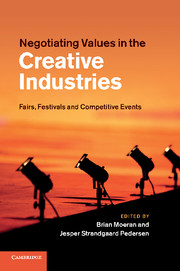Book contents
- Frontmatter
- Contents
- Figures
- Tables
- Contributors
- Acknowledgements
- Introduction
- 1 A Salon’s life
- 2 Art fairs
- 3 Biennalization and its discontents
- 4 Staging auctions
- 5 The book fair as a tournament of values
- 6 Inventing universal television
- 7 Transforming film product identities
- 8 Event institutionalization and maintenance
- 9 Tradition and transformation at the Fan Fair festival
- 10 Between art and commerce
- 11 Configuring sustainability at fashion week
- 12 An inconvenient truce
- 13 The retrospective use of tournament rituals in field configuration
- Afterword Converting values into other values
- Author index
- Subject index
- References
3 - Biennalization and its discontents
Published online by Cambridge University Press: 25 October 2011
- Frontmatter
- Contents
- Figures
- Tables
- Contributors
- Acknowledgements
- Introduction
- 1 A Salon’s life
- 2 Art fairs
- 3 Biennalization and its discontents
- 4 Staging auctions
- 5 The book fair as a tournament of values
- 6 Inventing universal television
- 7 Transforming film product identities
- 8 Event institutionalization and maintenance
- 9 Tradition and transformation at the Fan Fair festival
- 10 Between art and commerce
- 11 Configuring sustainability at fashion week
- 12 An inconvenient truce
- 13 The retrospective use of tournament rituals in field configuration
- Afterword Converting values into other values
- Author index
- Subject index
- References
Summary
Introduction
While most chapters in this volume use the examples of different forms of fairs or festivals to theorize the field-configuring (FCE) event from the standpoints of organizational sociology and anthropology, this essay derives from another kind of disciplinary apparatus. As an art historian who works at the intersection of post-war art and politics, and whose language and methods draw from the arts and humanities’ arsenal of aesthetics, theories of post-structuralism, politics and globalization, my tools bring me to another kind of analysis. In considering biennales, a type of art exhibition – characteristically large-scale, international and recurring – this chapter does not use the language of the FCE, because the temporality of these exhibitions exceeds the singularity of an event; it refuses the entitlement of biennales to configure the field of art; and forsakes an analysis of the micropolitics of bartering of power between the agents at biennales’ physical sites, for the broader ideological questions of how these events and positions figure current conditions of political economy.
Pierre Bourdieu’s notion of a field of production – wherein agents struggle for power and consequently define a field – has been taken up frequently to map the contingent exchanges of power between agents. However, the demystification of power’s protocols is not Bourdieu’s sole point, nor is it, in the strategic manoeuvring within a field, his ultimate concern. As his interlocutor, artist Andrea Fraser (2005: 57) notes, ‘The critique of the art object’s autonomy in this sense was less a rejection of artistic autonomy than a critique of the uses to which art works are put: the economic and political interests they serve’. If biennales are now increasingly part of the culture industry – this chapter asks, what interests do they serve? In writing an art history, one lends weight to one’s objects, and in describing a field, one attributes power to the movement of objects within it, and attempts to redirect their course. One step towards this lies in articulating the object of critique. Thus, my target of critique is not the individual biennale, nor its individual artists, critics and curators – who occasionally resist precisely what I critique – but the interests we are made to serve without our consent, and against our well being. Consequently, I consider a broad typology of biennalization (Nadarajan, 2006) – to refuse the animation and anthropomorphism of a single biennale, and the endowing of its invisible hand with independent life, when in reality it is saturated with and instrumentalized by the political. This chapter will consider biennales in the age of capital’s globalization, whose logic is both neo-liberal and nationalist. I consider the new subjectivity proposed by biennalization, whose erasure of cultural difference dovetails the rhetoric of the creative industries’ ‘creative worker’ exemplified by biennales’ transnational rhetoric. From the early 1990s onwards, the ‘biennalization’ of the art world progressed – particularly in developing nations – alongside the push towards the creative industries by governments worldwide, and coinciding with the rise of economic neo-liberalism. I argue that facets of this broader embrace of culture as a ‘creative industry’, of which biennalization is symptomatic, may be ultimately detrimental to the continued health of the arts and culture, and their workers.
- Type
- Chapter
- Information
- Negotiating Values in the Creative IndustriesFairs, Festivals and Competitive Events, pp. 73 - 93Publisher: Cambridge University PressPrint publication year: 2011
References
- 9
- Cited by



